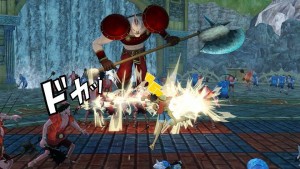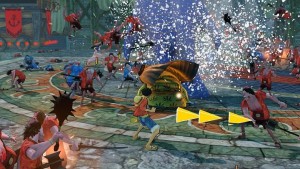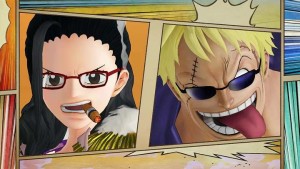One Piece: Pirate Warriors 3 is a third-person musou actionrole playing game available for download from the PlayStation Store for the PS Vita with compatibility for PlayStation T.V., while also releasing on PS4 and PS3. One Piece is a series of Japanese manga stories written and illustrated by Eiichiro Oda having been serialised in Shueisha’s Weekly Shonen Jump magazine since July 19th 1997 in which chapters have been compiled into at least 78 standalone Tankobon volumes centred upon the adventurous life of the lead character Monkey D. Luffy. One Piece is incredibly successful having sold over 300 million copies making it the best-selling manga in history, while having an even further outreach with an anime television series airing over 700 episodes in Japan since 1999 as well as releasing numerous novels, films, soundtrack albums, trading card games and videogames.
There have been many One Piece games released since One Piece: Become the Pirate King in 2000 on the WonderSwan and One Piece: Grand Battle on PS1 with a number of One Piece games released on numerous platforms ever since. One Piece: Pirate Warriors 3 is developed by Omega Force who has developed the two prequels in the One Piece: Pirate Warriors series which are published by Bandai Namco, while Omega Force is part of Koei Tecmo’s development teams and is also known for developing games in such well respected series as Dragon Quest Heroes, Dynasty Warriors, Samurai Warriors, Toukiden and Warriors Orochi, which are usually games set within the musou genre, therefore Omega Force delivers a huge amount of experience within the musou genre to the latest One Piece offering.
The story revolves around the lead character Monkey D. Luffy wanting to join Red-Haired Shanks’ crew of pirates when he was a small boy before skipping 10 years into the future to show him as a young man setting sail as a pirate in his attempt to assemble a crew to help him in his quest to become the Pirate King. For One Piece fans that are familiar with the core material; the story is set and occurs within 21 story arcs from the Romance Dawn arc until the Dressrosa Arc and also contains an original ending to the story. The story does not just play out during gameplay but also within comic book strips in the build up to each episode and prior to each mission contained inside of each episode which is an excellent design choice as it continuously evolves the progression of the story and maintains an appropriate pacing.
Legend Log allows the player to experience the original story with more playable characters unlocked as progression is made further through the story, while Free Log provides the player with an opportunity to choose any episode with any playable character in the story of Legend Log to unlock such features within, alongside Dream Log in which players select an unlocked playable character to do battle on islands against a variety of enemies who are randomly positioned with a suggested level the playable character should have reached before attempting a specific island.
The combat is reminiscent of what is anticipated from the musou genre such as the Dynasty Warriors series in regards to button bashing to perform a quick chain of combat manoeuvres on enemies, although there are some combat moves which require a sequence of buttons to perform special attacks which certainly adds a layer of skill for players who wish to learn them all, while certain playable characters have their own unique methods of attack such as Luffy’s body being capable of stretching in the form of rubber in order to punch and kick enemies further away than expected as he once accidentally ate a Devil Fruit, alongside a new combat feature called Kizuna Rush which allows the player to call upon other characters to participate in combination attacks.
Every playable character starts with specific statistics for their life, special attack, attack and defence which can be improved by earning XP to level up including defeating enemies, chaining together combinations of attacks, completing missions and completing entire episodes. The maximum level for each character is level 50 within normal conditions of gaining XP to level up, although players can beyond level 50 and to as high as level 100 by defeating strong enemies in higher level Dream Log stages and collecting rare character specific coins.
The character design is pretty good as the ally and enemy characters have their own unique look, shape and size in the sense that all of the ally characters look apart, while the enemies look similar to each other when grouped together, although there are regular and higher ranking enemies such as captains and commanders with special and boss enemies also making appearances, alongside a change in armour or weaponry for each group in each episode to provide some form of variation.
The environment and character design are as good as each other and there are noticeably large spacious environments to explore and battle throughout the entire map against various enemies with areas connecting to each other via large doors, bridges or jumping from above into the following base, although some of the bases will not become available until later into the battle when certain doors open after a battle has been won elsewhere on the map.
There is a gallery featuring unlockable items which are earned as the story progresses including biographies for all of the characters which appear in the story, definitions of terms that are important words mentioned in the game, an event gallery which plays videos from throughout the episodes of the story, a music gallery consisting of dozens of in-game background music tracks, a treasure list of items collected throughout the game such as coins and skill posters, a crew gallery containing allies with voice-overs and facial expressions unlocked separately and a legend diary which allows players to check the legend diary of each episode. A lot of the items are unlocked via natural progression through the story, although a fair amount of items have to be purchased by utilising the in-game currency of Beli which is earned for defeating enemies as well as successfully completing missions, episodes and chapters in order for players to be able to make purchases from the Beli Shop in which a variety of content including videos and music can be purchased for unlocking within the gallery.
There are multiple downloadable content packs available each comprising of 4 missions and 4 costumes and costing £6.49* each, while there is a Story Pack which effectively acts as a season pass containing both DLC packs with further costumes exclusively available in the Story Pack with all content totalling to 8 missions and 18 costumes for a cheaper bundled price of £9.49* which is even better value taking into consideration that all downloadable content is available for cross-buy purchase allowing players to play additional content for a single purchase on Vita, PS4 and PS3, alongside a Gold Edition of the game for the chosen platform which includes access to all of the downloadable content for all 3 PlayStation platforms.
One Piece: Pirate Warriors 3 supports cross-save functionality which allows players to sync the progression of their save file from their Vita to the PS3 or PS4 and vice versa, so players can start playing the game on their Vita on the way to and from work, sync the save game when they return home and then resume where they left off by loading the save game and continuing via the PS3 or PS4 version. The cross-save feature is made possible by uploading the save file to the cloud on one console and downloading it from the other from.
The controls are appropriately mapped to the Vita with the control scheme consisting of pressing square to perform a standard attack, pressing triangle to perform a ranged attack, pressing square and triangle together to perform a charged attack, pressing O to perform a special attack or to perform a special Kizuna Attack during Kizuna Rush, pressing X to evade or dash or during a combo attack to perform a chain, pressing up or down on the d-pad to change character, pressing left or right to change the scale of the mini-map, changing the direction of the left analogue stick to move the playable character, changing the direction of the right analogue stick to pan the camera, pressing select to perform a gesture such as putting on and taking off Luffy’s hat and pressing start to display the pause menu. Touch screen implementation features tapping the bottom left of the touch screen to turn on the lock-on feature and tapping the bottom right of the touch screen to perform a Kizuna Rush.
One Piece: Pirate Warriors 3 continuously maintains a high level of graphical quality across all of the characters, environments and combat manoeuvres throughout the entire game with a fluent frame-rate especially given that there are hundreds of enemies in battle on screen at any given moment which rivals the performance of the home console PS4 and PS3 versions, while Japanese writing is displayed stylistically when taking on enemies during battles and an unfolding story told in excellent comic book styled panels before an episode and prior to each mission within each episode.
The presentation of the game is solid with a great user interface across various menus such as the main, legend log, free log, dream log, online, gallery, options and gameplay menus with support for navigation via the left analogue stick, d-pad and face buttons, although there is no support for navigation via the right analogue stick, touch screen and rear touch pad. The background of the main menu consists of the lead character Luffy in the foreground as well as clouds and a map in the background.
Despite having no English language voice-overs; the Japanese voice-overs with English subtitles are faithful to the original One Piece anime television series by retaining all of the extremely talented and experienced voice-over artists for the large range of characters. Characters such as Mayumi Tanaka as Monkey D. Luffy, Kazuya Nakai as Roronoa Zoro, Akemi Okamura as Nami, Kappei Yamaguchi as Usopp, Hiroaki Hirata as Sanji, Ikue Otani as Tony Tony Chopper, Yuriko Yamaguchi as Nico Robin. Sound effects include playable characters aiming and performing combat moves on enemies, enemies retaliating in attack and running from base to base, while the music mostly consists of Japanese rock during gameplay with a mixture of tense climactic and adventurous music during story related comic strips and jazz arrangements during menu screens.
The trophy list includes 40 trophies with 23 bronze, 13 silver, 3 gold and 1 platinum trophy. The majority of the trophy list is earned through natural progression such as story related trophies for completing episodes and chapters, 2 bronze trophies for completing 5 and 15 islands in Dream Log, 3 bronze trophies for unleashing the first Kizuna Attack, Kizuna Rush and Hero Power; the We’re “Wanted Men” Now bronze trophy and the My Bounty is 400 Million Beli silver trophy for obtaining 1 and 20 skill posters respectively with a bronze and silver trophy on offer for obtaining 1 and 20 skills; as well as 2 bronze trophies and a silver trophy available for collecting 1, 50 and 100 types of coins. The hardest trophies are the We Know Everything in History gold trophy as it is the most time-consuming trophy due to requirements of completing the entire Legend for all Legend Log episodes and the Dream Log, completing the Crew Gallery and purchasing all movie dials and sound dials from the Beli Shop as well as maximising every character’s crew level and achieve an S rank in the process, alongside the People’s Dreams Never Die gold trophy for completing the final island in Dream Log which requires every strong enemy in the Dream Log to be defeated. It is estimated that depending upon skill and a good trophy guide to provide some helpful tips that it would take between 50 to 75 hours to platinum the trophy list.
There are 3 difficulty levels including easy, normal and hard with the major differences being more aggressive enemies which attack more regularly, inflicts more damage to the playable character and receives less damage from the playable character’s attacks, while S ranks are not obtainable on easy difficulty, alongside an unlockable extension to the Dream Log mode called Nightmare Log mode in which Dream Log mode continues on a difficulty which is so hard that it is recommended that players attain level 100 before even attempting to begin Nightmare Log mode.
 The performance of online multiplayer is exceptional as it is graphically identical and maintains the same consistent frame-rate of the single player despite being just as hectic with the on screen action and showing the second player whenever their character is nearby within the same base of the battle, while Ad Hoc multiplayer allows two players to connect wirelessly for a local multiplayer experience which offers exactly the same functionality as the online multiplayer.
The performance of online multiplayer is exceptional as it is graphically identical and maintains the same consistent frame-rate of the single player despite being just as hectic with the on screen action and showing the second player whenever their character is nearby within the same base of the battle, while Ad Hoc multiplayer allows two players to connect wirelessly for a local multiplayer experience which offers exactly the same functionality as the online multiplayer.
Online multiplayer effectively offers a co-operative experience for two players with both sharing a Kizuna Gauge rather than having their own individual one, allowing players to select a Quick Match which searches for an available match, while Create Match allows players to create a match consisting of an episode which has already been unlocked in the Legend Log during single player with a private match or public match enabling the host to invite a player and even allowing the host to play the chosen episode alone during the wait for another player to join the match and allowing the player to retain any XP and coins earned in the process.
Rescue Request is an interesting feature as it enables players to send and receive requests for help to and from other players when wanting a co-operative helping hand during episodes within Legend Log and Free Log modes with received Rescue Requests displaying next to episodes marked with SOS.
As great as the online and Ad Hoc multiplayer components are, it would have been better if it included competitive multiplayer such as a player playing as a good character and the other player playing as the evil counterpart which clash in battle on opposing sides, while the competitive multiplayer could be extended into a part competitive, part co-operative mode in which players can form two teams consisting of up to four players on either team, alongside such improvements as the host or joining player being able to continue if the other player leaves the session and the lack of cross-play online multiplayer between Vita, PS4 and PS3 being resolved.
The online leaderboards focuses on the top 100 players in online multiplayer with the leaderboard containing each player’s rank; name (PSN ID); pirate ranking; wanted ranking and country or region with the positioning of each player based upon the accumulation of wanted ranking points, although it would have been even better if more than the top 100 players would have been in the pirate rankings and if single player components would have also had online leaderboards such as how quickly each mission, episode and chapter has been completed as well as how many enemies have been defeated and how many territories have been captured with a ranking search filter for each statistic.
The replayability stems from a variety of features such as the Legend Log, Free Log and Dream Log modes with the unlockable Nightmare Log mode which extends Dream Log mode, while the online multiplayer and Ad Hoc multiplayer components offer co-operative multiplayer for two players and online leaderboards provide a general competitiveness to online multiplayer gameplay, alongside ranks to score the player’s performance and dozens of unlockable gallery items which will collectively keep players returning for a substantial period of time.
Overall, One Piece: Pirate Warriors 3 delivers an exceptional portable effort which captures frenetic Dynasty Warriors style gameplay with humorous dialogue from the intriguing characters and set within the world of One Piece on Vita; therefore if you are a fan of One Piece, the musou genre or Omega Force games, then One Piece: Pirate Warriors 3 is an absolute must purchase on Vita.
Jason Bonnar
Analysis
- Title: One Piece: Pirate Warriors 3
- Developer: Omega Force (subsidiary of Koei Tecmo)
- Publisher: Bandai Namco Entertainment
- System: PS Vita
- Format: PS Vita Card/PSN Download
- Cross-Buy: Yes (Downloadable content)
- Cross-Play: Yes (Cross-Save)
- Players: 1-2 (Online Co-operative Multiplayer/Ad Hoc)/Online Leaderboards
- Memory Card Space Required: 1MB (PS Vita Card)/2.8GB (PSN Download)*
- *Correct at time of publication

